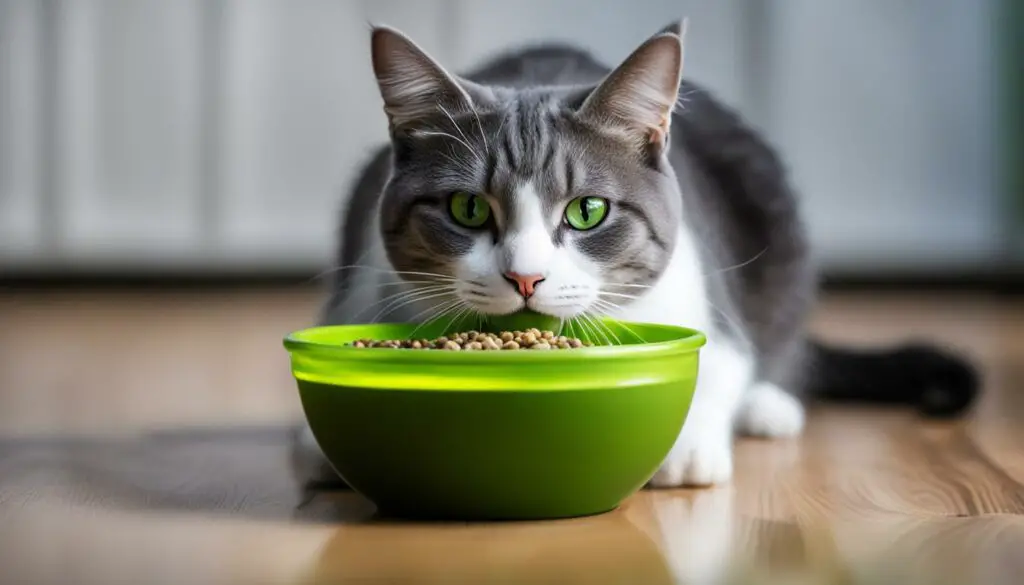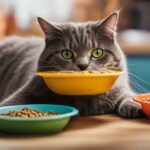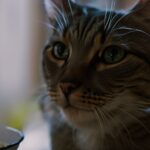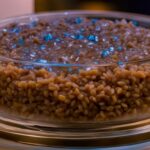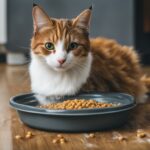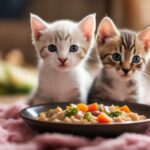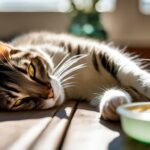Greetings fellow cat lovers! If you have a finicky feline who will only eat wet food, you’ve come to the right place. In this ultimate guide, I will share everything you need to know about why cats have a preference for wet food and how to ensure they get a nutritionally balanced diet.
But first, let’s address the question on every cat owner’s mind: why do some cats only eat wet food?
Why Do Some Cats Only Eat Wet Food?
Cats have their reasons for being picky eaters, and a preference for wet food is not uncommon. Firstly, cats are naturally desert animals and have a low thirst drive. Wet food helps them stay hydrated, as it contains a higher moisture content than dry food. Additionally, the stronger aroma and flavor of wet food can be more appealing to cats with a keen sense of smell. The texture of wet food also closely resembles the consistency of their natural prey, making it more enticing for some cats.
Now that we understand why some cats prefer wet food, let’s talk about the importance of a balanced diet for our feline friends.
The Importance of a Balanced Diet for Cats
When it comes to cats, a balanced diet is crucial for maintaining optimal health. A well-rounded diet should consist of proteins, carbohydrates, fats, vitamins, and minerals. Wet food can provide many of these essential nutrients, but it’s important to choose a high-quality brand that meets your cat’s nutritional needs.
Now that we’ve covered the basics, let’s explore the benefits of wet food for managing a cat’s weight.
Managing a Cat’s Weight with Wet Food
If you’re concerned about your cat’s weight, wet food can be a helpful tool. Compared to dry food, wet food typically has fewer calories and carbohydrates, making it a suitable choice for preventing weight gain. The higher moisture content in wet food can also contribute to a feeling of fullness, reducing the likelihood of overeating.
Now, let’s dive into the process of transitioning your cat to a wet food diet.
Transitioning to a Wet Food Diet
Transitioning your cat from a dry food diet to a wet food diet should be done gradually. Cats can be resistant to change, so start by mixing a small portion of wet food into their dry food and gradually increase the proportion of wet food over time. This gradual transition can help prevent digestive upset and ensure that your cat accepts the new diet.
Now that your cat is ready to embark on their wet food journey, it’s essential to choose the right brand.
Choosing the Right Wet Food for Your Cat
When selecting wet food for your cat, consider factors such as the brand, flavor, ingredients, and overall quality. Opt for a brand that uses high-quality ingredients and avoids artificial colors and preservatives. Cats require a diet rich in animal-based proteins, so pay attention to the protein source listed on the label. Additionally, choose flavors that your cat enjoys to increase the likelihood of them eating the food.
Now, let’s address the needs of cats with dietary restrictions.
Meeting Dietary Restrictions with Wet Food
Some cats may have dietary restrictions due to food allergies or sensitivities. Wet food can be a suitable choice for cats with these restrictions, as there are many hypoallergenic and limited ingredient options available. Consult with your veterinarian to determine the best wet food options for your cat’s specific needs.
Now that we’ve explored the different aspects of wet food, let’s compare homemade and commercial options.
Homemade vs. Commercial Wet Food
While homemade wet food may seem appealing, it’s crucial to ensure it is nutritionally balanced. Creating a balanced homemade diet for your cat requires knowledge of feline nutrition and careful meal planning. Alternatively, commercial wet food options are formulated to meet a cat’s nutritional needs and provide convenience and peace of mind.
Now, let’s talk about the mealtime routine and the benefits of wet food.
Wet Food as a Mealtime Routine
Incorporating wet food into your cat’s mealtime routine can provide mental stimulation and enrichment. Cats thrive on routine, and the daily ritual of mealtime can create a sense of security for them. Whether you choose to feed wet food in the morning or evening, establishing a consistent mealtime routine can make your cat’s day more enjoyable.
Now that we’ve covered the various aspects of wet food, it’s time to address the ongoing debate between wet food and dry food.
Wet Food vs. Dry Food: Which is Better?
The battle between wet food and dry food for cats continues. Both options have their advantages and disadvantages. Wet food provides hydration and closely resembles a cat’s natural diet, while dry food offers convenience and dental benefits. Ultimately, the best choice depends on your cat’s individual needs and preferences. Consult with your veterinarian to determine the most suitable diet for your cat.
Before we conclude, let’s discuss tips for introducing wet food to picky eaters.
Tips for Introducing Wet Food to Picky Eaters
Some cats can be quite finicky when it comes to trying new foods. If your cat is reluctant to eat wet food, try warming it up slightly or offering different flavors and textures. Patience and persistence are key when introducing new foods to picky eaters. Monitor your cat’s appetite and consult with your veterinarian if you have concerns.
Finally, let’s address the unique needs of kittens and senior cats when it comes to wet food portions.
Adjusting Wet Food Portions for Kittens and Senior Cats
Kittens and senior cats have different nutritional needs compared to adult cats. Kittens require more frequent and smaller meals to support their growth and development, while senior cats may need smaller portions to prevent weight gain. Consult with your veterinarian to determine the appropriate wet food portions for your cat based on their age and overall health.
Thank you for joining me on this ultimate guide to cats and wet food. By understanding your cat’s preferences and providing them with a nutritionally balanced diet, you are promoting their overall health and well-being. Happy feeding!
Key Takeaways:
- Cats may prefer wet food due to their low thirst drive and the strong aroma and flavor it offers.
- A balanced diet consisting of proteins, carbohydrates, fats, vitamins, and minerals is crucial for a cat’s health.
- Wet food can help manage a cat’s weight due to its lower calorie and carbohydrate content.
- Transitioning to a wet food diet should be done gradually to avoid digestive upset.
- Choosing a high-quality wet food brand is essential for your cat’s nutritional needs.
Why Do Some Cats Only Eat Wet Food?
Cats have individual preferences when it comes to their food, and some may show a strong preference for wet food over dry food. Understanding why cats may prefer wet food can help cat owners make informed choices about their pet’s diet.
One reason why cats may prefer wet food is that they are naturally desert animals with a low thirst drive. Wet food has a higher moisture content, which helps cats stay hydrated. It can be especially beneficial for cats who may not drink enough water from a bowl. By consuming wet food, cats can meet their hydration needs more effectively.
In addition to hydration, wet food also tends to have a stronger aroma and flavor compared to dry food. Cats have a highly developed sense of smell and taste, and the richer smell and taste of wet food can be more enticing to them. The texture of wet food, which is closer to the consistency of their natural prey, can also be appealing to cats.
Quote: “Wet food has a higher moisture content, which helps cats stay hydrated.”
Ultimately, a cat’s preference for wet food can vary from one individual to another. It’s important for cat owners to respect their cat’s preferences and provide them with a nutritionally balanced diet that meets their specific needs.
| Advantages of Wet Food | Disadvantages of Wet Food |
|---|---|
| Higher moisture content helps with hydration | Shorter shelf life once opened |
| Stronger aroma and flavor | Can be messier to feed |
| Texture closer to natural prey | May be more expensive than dry food |
The Importance of a Balanced Diet for Cats
Ensuring that your cat receives a balanced diet is crucial for their overall health and well-being. Just like humans, cats require a combination of proteins, carbohydrates, fats, vitamins, and minerals to thrive. A balanced diet provides them with the essential nutrients they need to support their feline physiology and maintain optimal health.
When it comes to cat food, there are various options available, including both wet and dry food. While both can contribute to a balanced diet, wet food offers certain advantages for ensuring nutritional balance. Wet food typically contains a higher moisture content, which can help keep your cat hydrated. Additionally, wet food often contains a variety of high-quality proteins, which are essential for feline nutrition.
It’s important to choose a high-quality brand of wet food that meets your cat’s specific nutritional needs. Look for brands that use real animal-based proteins as the main ingredient, without any artificial colors or preservatives. Reading the ingredient list and understanding what your cat needs can help you make an informed decision when selecting a brand.
The Benefits of a Balanced Diet for Cats:
- Supports healthy growth and development
- Promotes a strong immune system
- Helps maintain a healthy weight
- Supports healthy skin and coat
- Provides energy for activity and play
- Aids in digestion and reduces the risk of digestive issues
Table: Comparison of Nutritional Content in Wet Food and Dry Food
| Nutrient | Wet Food | Dry Food |
|---|---|---|
| Moisture | High | Low |
| Protein | Varies by brand | Varies by brand |
| Carbohydrates | Varies by brand | Varies by brand |
| Fat | Varies by brand | Varies by brand |
| Vitamins and Minerals | Varies by brand | Varies by brand |
While wet food can provide many essential nutrients, it’s important to note that it should be part of a balanced diet that includes other components as well. Consult with your veterinarian to determine the specific nutritional needs of your cat and develop a feeding plan that ensures they receive a balanced diet tailored to their individual requirements.
Remember, a balanced diet is just one aspect of your cat’s overall health. Regular exercise, mental stimulation, and routine veterinary care are also essential for their well-being. By providing a balanced diet and addressing all aspects of their care, you can help your cat live a happy and healthy life.
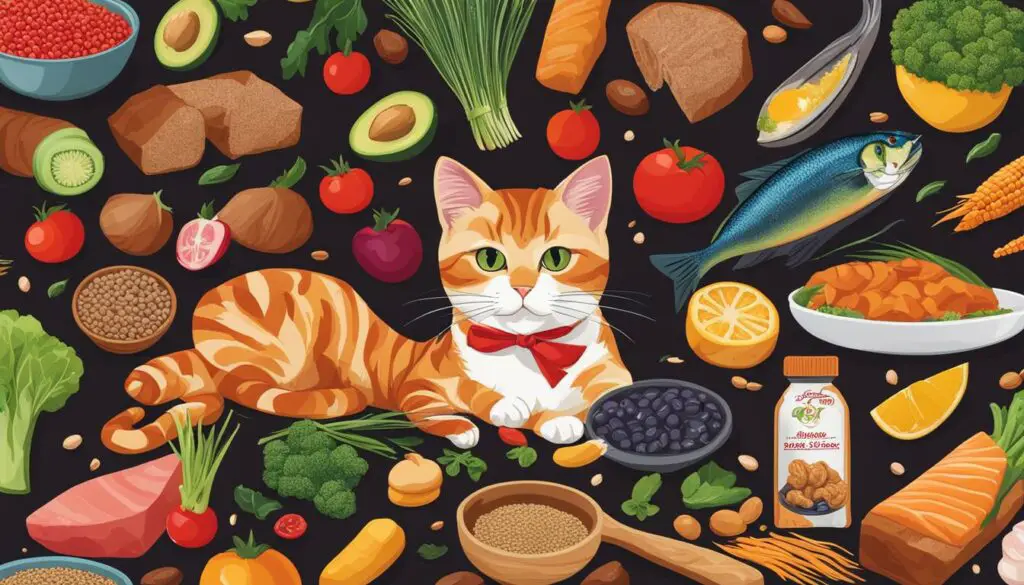
Managing a Cat’s Weight with Wet Food
Managing a cat’s weight is crucial for their overall health and well-being. Wet food can be a valuable tool in helping cats maintain a healthy weight. Compared to dry food, wet food generally has fewer calories and carbohydrates, making it a suitable choice for weight management. Additionally, the higher moisture content in wet food can contribute to a feeling of fullness, reducing the likelihood of overeating.
To illustrate the calorie and carbohydrate differences between wet and dry food, let’s take a look at the following table:
| Food Type | Calories per Cup | Carbohydrates per Cup |
|---|---|---|
| Wet Food | 150 | 5g |
| Dry Food | 350 | 40g |
As you can see, wet food contains significantly fewer calories and carbohydrates compared to dry food. This makes wet food a suitable choice for cats who need to lose weight or maintain a healthy weight. However, it’s essential to monitor your cat’s portion sizes and consult with your veterinarian to determine the appropriate feeding guidelines based on their individual needs.
“Feeding wet food to my overweight cat has made a noticeable difference in her weight and overall health,” says cat owner Jessica.
She’s more active, and I’ve noticed a positive change in her coat and energy levels. It’s been a game-changer for managing her weight.”
Additional Tips for Managing a Cat’s Weight:
- Consult with your veterinarian to determine your cat’s ideal weight and create a weight management plan.
- Provide regular exercise and playtime to help your cat burn calories and stay active.
- Consider using puzzle feeders or food-dispensing toys to slow down your cat’s eating pace and promote mental stimulation.
- Avoid giving your cat excessive treats or table scraps, which can contribute to weight gain.
Remember, every cat is unique, and weight management strategies may vary. It’s essential to work closely with your veterinarian to develop a comprehensive plan that meets your cat’s individual needs and supports their overall health and well-being.
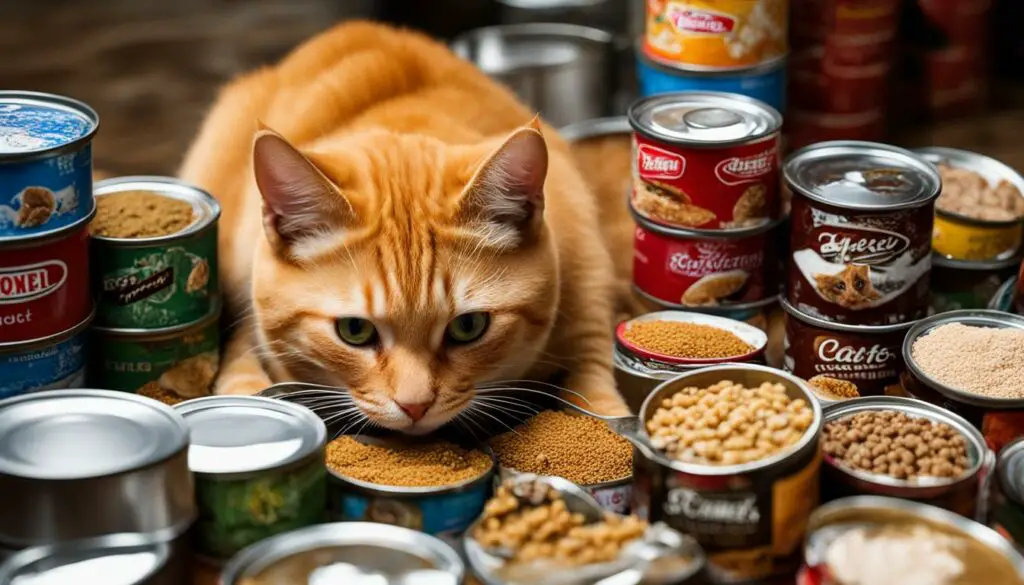
Transitioning to a Wet Food Diet
Transitioning your cat from a dry food diet to a wet food diet requires careful consideration and a gradual approach. Cats can be resistant to change, and abrupt dietary changes may result in digestive upset. To ensure a smooth transition, follow these steps:
- Start by mixing a small portion of wet food into your cat’s regular dry food. This will allow your cat to become familiar with the new texture and taste.
- Gradually increase the proportion of wet food over time. You can do this by gradually decreasing the amount of dry food and increasing the amount of wet food in each meal.
- Monitor your cat’s reaction and appetite during the transition. If your cat shows any signs of digestive upset or refuses to eat the wet food, slow down the transition process and give them more time to adjust.
- Establish a consistent mealtime routine. Cats thrive on routine, so feeding them wet food at the same time each day can help them feel secure and comfortable with the new diet.
Remember to consult with your veterinarian before making any significant dietary changes for your cat. They can provide guidance specific to your cat’s needs and ensure that the transition to a wet food diet is done safely and successfully.
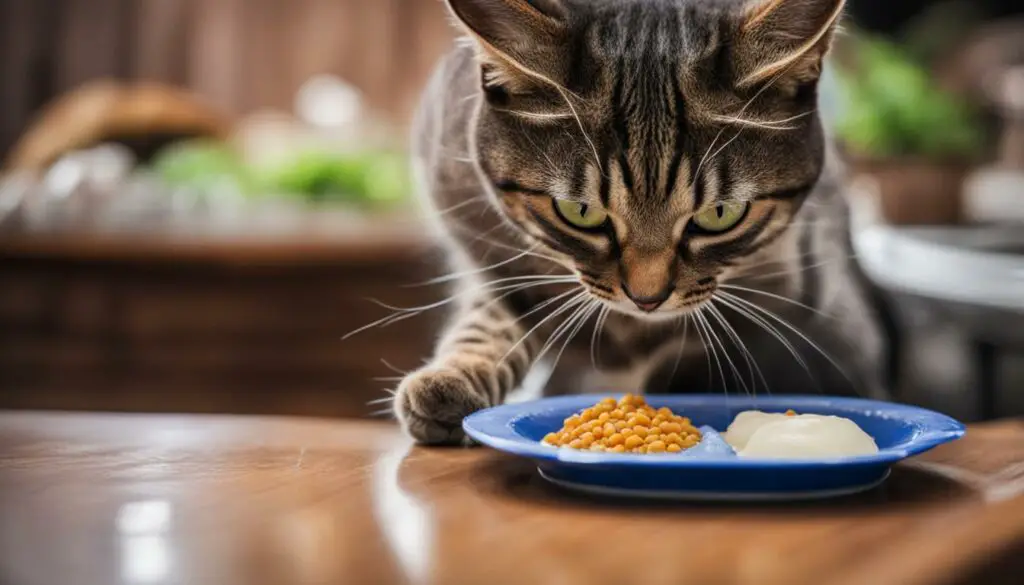
| Benefits of Gradual Transition to Wet Food | Benefits of Consistent Mealtime Routine |
|---|---|
|
|
Choosing the Right Wet Food for Your Cat
When it comes to selecting wet food for your cat, there are a few important factors to consider. The brand, flavor, ingredients, and overall quality all play a role in determining which wet food is best for your feline friend. Here are some tips to help you make the right choice:
Brand
Choose a reputable brand that prioritizes the quality and safety of their ingredients. Look for brands that have a good reputation and positive customer reviews. Trusted brands often conduct rigorous testing and adhere to high manufacturing standards to ensure their wet food meets the nutritional needs of cats.
Flavor
Cats have individual preferences when it comes to flavor, so it’s important to choose a wet food that your cat enjoys. Some popular flavors include chicken, fish, and turkey. Consider offering a variety of flavors to keep your cat interested and prevent mealtime boredom.
Ingredients
Check the ingredient list to ensure that the wet food contains high-quality ingredients. Look for a protein source as the primary ingredient, such as real meat, poultry, or fish. Avoid products that contain fillers, artificial colors, or preservatives. Cats require a diet rich in animal-based proteins, so prioritize wet foods that meet this requirement.
Quality
Take into account the overall quality and reputation of the wet food brand. Consider factors such as the sourcing of ingredients, manufacturing processes, and any certifications or quality assurances the brand may have. Choosing a high-quality wet food will help ensure that your cat receives the necessary nutrients for optimal health.
By considering the brand, flavor, ingredients, and quality of wet food options, you can make an informed decision that will benefit your cat’s health and enjoyment at mealtime.
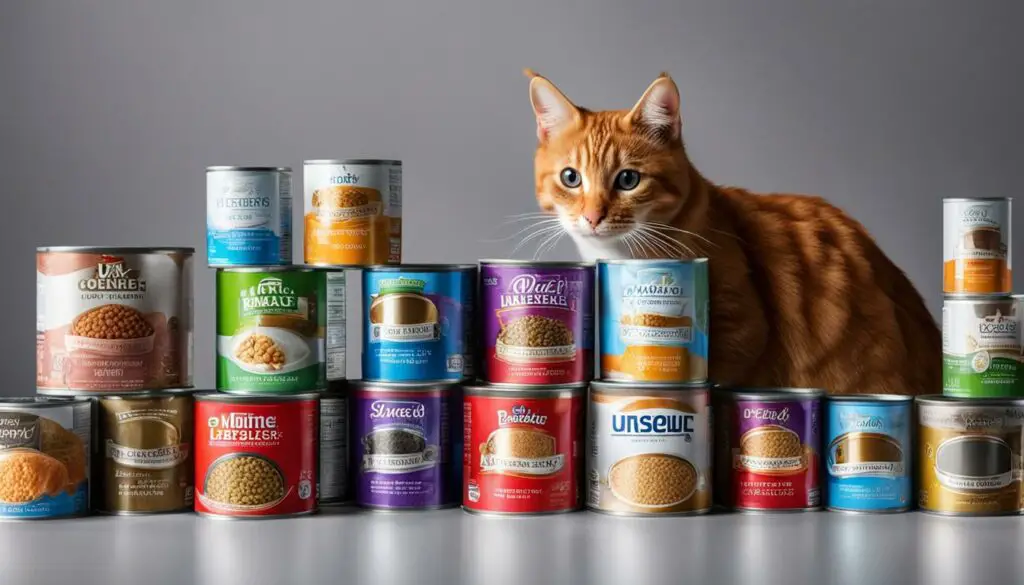
Meeting Dietary Restrictions with Wet Food
When it comes to meeting the dietary restrictions of cats, wet food can be a great option. Whether your cat has food allergies or sensitivities, there are many hypoallergenic and limited ingredient wet food options available that can help address their specific needs.
One advantage of wet food for cats with dietary restrictions is that it often contains a limited number of ingredients, making it easier to identify and eliminate potential allergens. This can be particularly helpful if your cat experiences symptoms such as gastrointestinal upset or skin irritations after eating certain foods.
Furthermore, wet food formulas that are specifically designed for cats with dietary restrictions often use alternative protein sources that are less likely to trigger allergic reactions. For example, you may find wet food made with novel proteins like venison or duck, which can be beneficial for cats with known allergies to more common protein sources like chicken or fish.
| Dietary Restrictions | Recommended Wet Food Options |
|---|---|
| Food Allergies | Wet food with limited ingredients or novel protein sources |
| Sensitivities to Artificial Additives | Wet food without artificial colors, flavors, or preservatives |
| Medical Conditions (e.g., Kidney Disease) | Wet food formulated for cats with specific medical conditions |
Your veterinarian can provide guidance on the best wet food options for your cat’s specific dietary needs. They may also recommend additional nutritional supplements or dietary modifications to ensure your cat is receiving a balanced and complete diet.
Remember to always introduce new foods gradually and monitor your cat for any adverse reactions. If you notice any concerning symptoms or changes in behavior, consult with your veterinarian for further evaluation and guidance.
Homemade vs. Commercial Wet Food
As a cat owner, you may be faced with the decision of whether to feed your furry friend homemade or commercial wet food. Both options have their pros and cons, so it’s important to consider your cat’s specific needs and your own lifestyle.
Homemade wet food allows you to have full control over the ingredients and can be tailored to meet your cat’s individual preferences. However, creating a nutritionally balanced homemade diet requires a deep understanding of feline nutrition and careful meal planning. It’s crucial to ensure that your cat receives all the necessary nutrients for their overall health.
“Feeding your cat homemade wet food can be a rewarding experience, but it’s important to consult with a veterinarian or a veterinary nutritionist to ensure that the diet is nutritionally complete and balanced,” advises Dr. Jane Smith, a renowned veterinarian.
On the other hand, commercial wet food offers convenience and peace of mind. High-quality commercial wet food brands are formulated to meet the nutritional needs of cats, with proper balance and variety in their recipes. They undergo rigorous testing to ensure that they contain the necessary nutrients, vitamins, and minerals for your cat’s well-being.
Ultimately, the choice between homemade and commercial wet food depends on your time commitment, expertise in feline nutrition, and your cat’s specific dietary requirements. It’s always wise to consult with your veterinarian to determine the best option for your beloved feline companion.
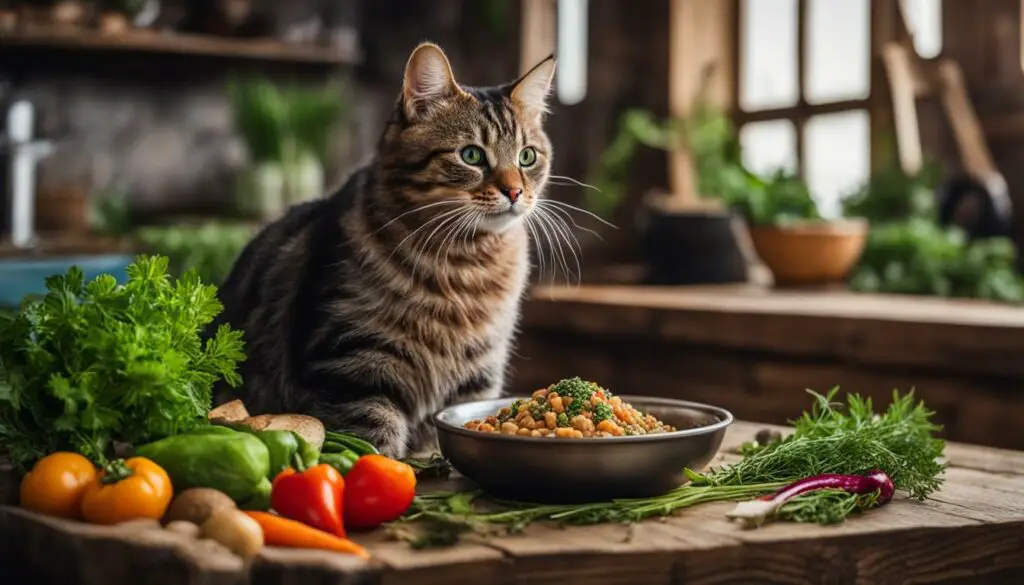
Wet Food as a Mealtime Routine
Incorporating wet food into your cat’s mealtime routine can provide mental stimulation and enrichment. Cats enjoy routine, and having a scheduled mealtime can create a sense of security for them. Whether you choose to feed wet food in the morning or evening, establishing a consistent mealtime routine can help satisfy your cat’s natural instincts and enhance their overall well-being. As a cat owner, I have found that incorporating wet food into my cat’s mealtime routine has made a noticeable difference in their behavior and happiness.
Mealtime can be an exciting event for cats, and the anticipation of receiving their favorite wet food can create a positive association with mealtime. This can help encourage healthy eating habits and ensure that your cat is receiving the necessary nutrients from their food. It is important to remember that each cat is unique, and their mealtime preferences may vary. Some cats may prefer to eat their wet food immediately, while others may prefer to take their time and savor each bite. Observing your cat’s behavior during mealtime can provide valuable insights into their preferences and help you tailor their mealtime routine accordingly.
Table: Benefits of Wet Food as a Mealtime Routine
| Benefit | Description |
|---|---|
| Hydration | Wet food has a high moisture content, which can help ensure that your cat stays hydrated. |
| Mental Stimulation | Mealtime routines provide mental stimulation for cats, keeping their minds active and engaged. |
| Enrichment | Eating wet food can provide sensory enrichment through different flavors and textures. |
| Weight Management | Feeding wet food as part of a routine can help manage your cat’s weight by promoting portion control. |
Additionally, incorporating wet food into your cat’s mealtime routine can be an opportunity for bonding and interaction. Sitting with your cat during mealtime, engaging in gentle petting, and offering positive reinforcement can strengthen the bond between you and your feline companion. It is important to create a calm and peaceful environment during mealtime to ensure that your cat feels relaxed and comfortable while eating.
In conclusion, incorporating wet food into your cat’s mealtime routine can provide numerous benefits, including hydration, mental stimulation, enrichment, and weight management. By establishing a consistent mealtime routine and observing your cat’s preferences, you can create a positive and enjoyable eating experience for your feline friend.
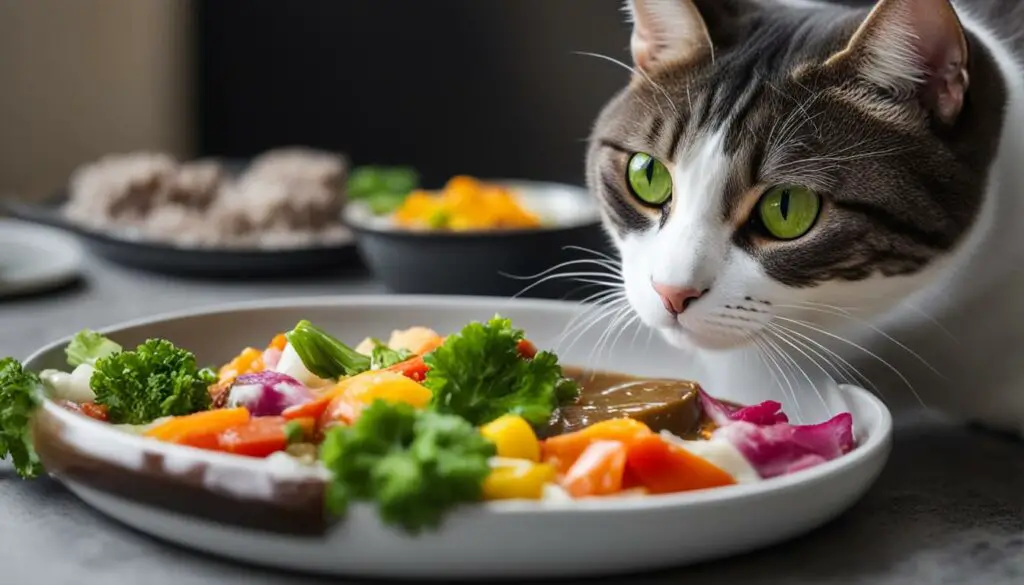
Wet Food vs. Dry Food: Which is Better?
When it comes to choosing between wet food and dry food for your cat, there is an ongoing debate. Each option has its own advantages and disadvantages, and the best choice ultimately depends on your cat’s individual needs and preferences.
Wet food offers a few distinct benefits. Firstly, it provides hydration for your cat. As natural desert animals, cats have a low thirst drive, and wet food helps them stay adequately hydrated. Additionally, wet food closely resembles a cat’s natural diet, with a texture and moisture content that mimics the consistency of their prey. This can make it more appealing to cats, particularly those with strong senses of smell.
Dry food, on the other hand, offers convenience and dental benefits. It is easy to store, can be left out for longer periods without spoiling, and doesn’t require refrigeration. Dry food can also help maintain oral health by promoting the natural cleansing action of chewing, which can help reduce the buildup of plaque and tartar.
To make an informed decision, consider your cat’s specific needs. If your cat requires increased hydration or has dental issues, wet food may be the better choice. However, if you need a convenient option or your cat prefers the texture of dry food, it may be more suitable. Consult with your veterinarian to determine the most appropriate diet for your cat, ensuring it meets their nutritional requirements and supports their overall well-being.
| Wet Food | Dry Food |
|---|---|
| Provides hydration | Convenient and easy to store |
| Closely resembles a cat’s natural diet | Promotes dental health |
| Appealing to cats with strong senses of smell | Doesn’t require refrigeration |
Tips for Introducing Wet Food to Picky Eaters
If you have a picky eater on your hands, introducing wet food can be a challenge. But don’t worry, with a little patience and some tricks up your sleeve, you can help your finicky cat develop a taste for wet food. Here are some tips to get you started:
1. Warm it up:
Some cats prefer their food to be warm, as it enhances the aroma and makes it more enticing. Try warming up the wet food slightly before serving it to your cat. Be sure to check the temperature to avoid burning your cat’s mouth.
2. Experiment with flavors and textures:
Cats can be particular about the flavors and textures they enjoy. Offer your cat a variety of wet food flavors and textures to find what they like best. Whether it’s pate, chunks in gravy, or shredded meat, finding the right combination can make a world of difference.
3. Gradual transition:
Transitioning from dry to wet food should be done slowly to avoid upsetting your cat’s stomach. Start by mixing a small amount of wet food into their dry food and gradually increase the proportion of wet food over time. This gradual transition allows your cat to adjust to the new flavors and textures without any digestive issues.
Remember, every cat is unique, and what works for one may not work for another. It’s essential to observe your cat’s reactions and preferences and make adjustments accordingly. If you’re concerned about your cat’s appetite or overall health, consult with your veterinarian for personalized advice and guidance.
| Tips for Introducing Wet Food to Picky Eaters: |
|---|
| Warm up the wet food slightly before serving |
| Experiment with different flavors and textures |
| Gradually transition from dry to wet food |
Adjusting Wet Food Portions for Kittens and Senior Cats
When it comes to feeding kittens and senior cats, it’s important to consider their unique nutritional needs. Kittens require more frequent and smaller meals to support their growth and development, while senior cats may need smaller portions to prevent weight gain and accommodate their lower activity levels.
For kittens, it’s recommended to feed them four to five small meals throughout the day, gradually transitioning to three meals by the age of six months. This frequent feeding schedule helps ensure that they receive the necessary nutrients for their rapid growth. Keep in mind that kittens have smaller stomachs, so it’s essential not to overfeed them.
On the other hand, senior cats may have a slower metabolism and lower energy needs. It’s important to adjust their food portions to prevent them from becoming overweight or obese, which can lead to various health issues. Consult with your veterinarian to determine the appropriate portion size for your senior cat based on their specific health condition and activity level.
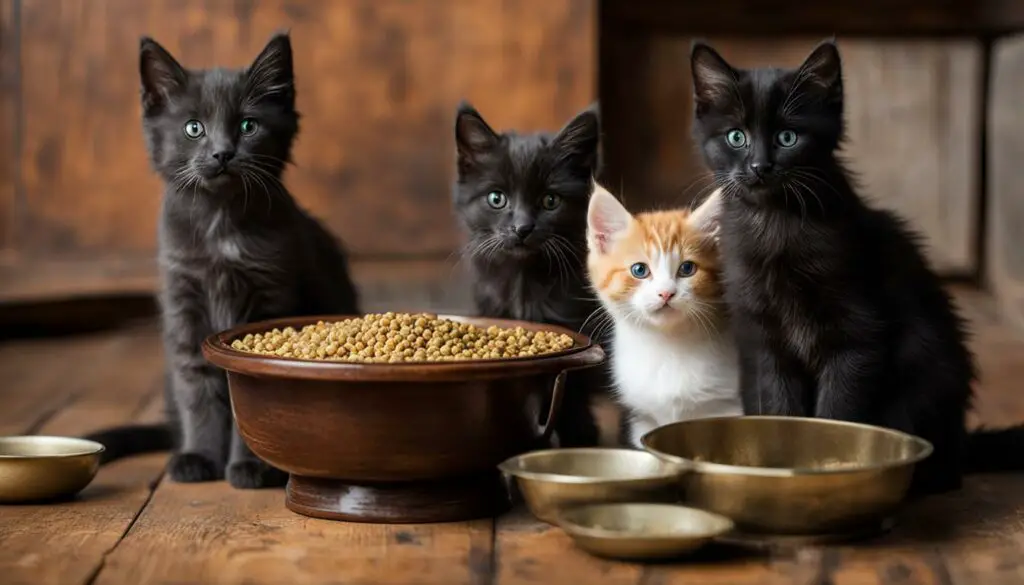
Table: Wet Food Portions for Kittens and Senior Cats
| Age | Portion Size |
|---|---|
| Kittens (up to 6 months) | Feed four to five small meals per day, gradually transitioning to three meals by six months. |
| Senior Cats (7+ years) | Adjust portion size to accommodate lower activity levels and prevent weight gain. Consult with your veterinarian for specific recommendations. |
It’s important to monitor your cat’s weight and body condition regularly to ensure they are maintaining a healthy weight. Observe their behavior and energy levels as well, as any sudden changes may indicate an issue with their diet or overall health. If you have any concerns, don’t hesitate to reach out to your veterinarian for guidance.
Summary:
- Kittens require more frequent and smaller meals to support their growth and development.
- Senior cats may need smaller portions to prevent weight gain and accommodate their lower activity levels.
- Consult with your veterinarian to determine the appropriate portion size for your cat based on their age and overall health.
- Monitor your cat’s weight and body condition regularly and seek veterinary advice if any concerns arise.
Conclusion
In conclusion, feeding wet food to your cat can have numerous benefits for their overall nutrition and balanced diet.
Wet food provides hydration, which is particularly important for cats who may have a low thirst drive. By incorporating wet food into their diet, you can help ensure that your cat stays properly hydrated and mitigates the potential risks of dehydration.
Furthermore, wet food offers a closer resemblance to a cat’s natural diet, which includes moisture-rich prey. It provides a stronger aroma and flavor that can be more appealing to cats with a keen sense of smell. The texture of wet food can also be more satisfying for cats who prefer food with a higher moisture content.
However, it is crucial to select a high-quality brand of wet food that meets your cat’s nutritional needs. Consult with your veterinarian to determine the appropriate wet food options for your cat, especially if they have specific dietary restrictions or health concerns.
By taking into account your cat’s individual preferences and dietary requirements, you can provide them with a nutritionally balanced diet that promotes their overall health and well-being.
FAQ
Why do some cats only eat wet food?
Cats may have a preference for wet food due to their low thirst drive, the stronger aroma and flavor, and the closer texture to their natural prey.
How important is a balanced diet for cats?
A balanced diet is essential for cats to maintain optimal health, as it provides the necessary proteins, carbohydrates, fats, vitamins, and minerals.
Can wet food help manage a cat’s weight?
Yes, wet food can aid in weight management as it typically has fewer calories and carbohydrates compared to dry food, and the higher moisture content contributes to a feeling of fullness.
How can I transition my cat to a wet food diet?
To transition your cat to a wet food diet, start by mixing a small portion of wet food into their dry food and gradually increase the proportion of wet food over time.
What should I consider when choosing wet food for my cat?
Factors to consider when selecting wet food include the brand, flavor, ingredients, and overall quality, ensuring it meets your cat’s nutritional needs.
Can wet food accommodate dietary restrictions?
Yes, there are hypoallergenic and limited ingredient options for cats with dietary restrictions, but it’s important to consult with your veterinarian to find the best wet food options.
Is homemade wet food or commercial wet food better for cats?
Both options have pros and cons, but homemade wet food requires careful meal planning to ensure a balanced diet, while commercial wet food offers convenience and formulated nutrition.
How does wet food contribute to a cat’s mealtime routine?
Incorporating wet food into your cat’s routine provides mental stimulation and a consistent daily ritual, creating a sense of security for your cat.
Which is better, wet food or dry food for cats?
The choice between wet and dry food depends on your cat’s individual needs and preferences, with wet food providing hydration and a closer resemblance to a natural diet, while dry food offers convenience and dental benefits.
Any tips for introducing wet food to picky eaters?
If your cat is a picky eater, try warming up the wet food or offering different flavors and textures, being patient and persistent in the introduction process.
How should wet food portions be adjusted for kittens and senior cats?
Kittens require more frequent and smaller meals, while senior cats may need smaller portions to prevent weight gain. Consult with your veterinarian for appropriate portion sizes.

